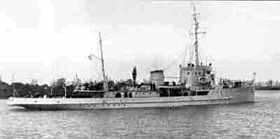Fournier (ship)
|
|
|
|---|---|
 The Fournier |
|
| Overview | |
| Type | Minesweeper |
| Shipyard | |
| Launch | August 5, 1939 |
| Commissioning | October 13, 1940 |
| Technical specifications | |
| displacement |
450 t (max. 520 t) |
| length |
59.35 m over everything |
| width |
7.3 m |
| Draft |
2.6 m |
| crew |
62 men |
| drive |
2 MAN - diesel engines 2,000 hp , 2 screws |
| speed |
15 kn |
| Range |
6000 nm |
| Armament |
|
| Fuel supply |
50 tons of diesel oil |
| Sister boats |
Drummond M-2, Robinson M-3, Granville M-4, |
The mine clearance boat Fournier M-5 was a ship of the Argentine Navy, built by the "Astillero Sánchez y Cía." In San Fernando , Buenos Aires . It was one of the first warships built in Argentina since 1825 and was launched on August 5, 1939.
Sinking of the ship
On the morning of September 21, 1949, the Fournier ran with a crew of 72 men under the command of Captain Carlos Negri from Río Gallegos , with the destination port of Ushuaia , where she should call on September 24. There are two possible routes for such trips: 1) the one along the east coast of Tierra del Fuego is dangerous because of the open sea; 2) the usually less dangerous route through Chilean territorial waters : Strait of Magellan , Magdalena Channel, Breadnock Channel, Ballenero Channel and then Beagle Channel to Ushuaia. In accordance with the unresolved sovereignty issues in the region, the Argentine Navy had not registered the mine sweeping boat's journey through the Chilean waters.
On the night of September 21-22, the ship passed the lighthouses of Punta Delgada (Primera Angostura) and San Isidro (both on the Strait of Magellan). These are the last confirmed findings about the fate of the ship. Exceptionally strong winds were recorded in the Strait of Magellan that night.
When radio contact with the ship could not be established from Ushuaia on September 22, the Argentine Navy initiated a search operation, and some time afterwards the Chilean Navy also took part in the search.
An extensive search operation, the Chilean involved patrol boat Lautaro with 60 men on board and the launch Isaza with 45 men on board, to aircraft of the Chilean Air Force . The Argentine Navy participated with the troop transport San Julián , the ship Spiro , the tug Chiriguano and Sanavirón , the research ship Bahía Blanca and the frigate Trinidad . This dramatic task was the first collaboration between the two navies.
The search area extended from Primera Angostura to Ushuaia, in an extremely sparsely populated region with fjords , branched canals, bays, dangerous currents, swell from different directions and narrow fairways .
Due to ignorance of the Chilean conventions , Argentine search ships had overlooked the warning signals of a lonely resident in the bay of Caleta Zig-Zag on the Gabriel Channel (on the south side of Dawson Island ). When the error was revealed through inquiries and one hurried to the resident, he reported a gruesome find. He had seen a boat go by a few days ago, and when he caught up with it he found two bodies in it that he had to bury on the beach.
So the search area could be narrowed down to twenty nautical miles. A little later, the bodies of two sailors were found in the Gabriel Canal. With the help of makeshift aerial photographs , a boat with five lifeless bodies of seamen who had died of hypothermia was found. All of their clocks showed 5:25 a.m. from which the time of the tragedy was deduced.
These nine corpses, two boats and some remains of the ship and cargo were all that could be found from the Fournier .
The accident caused great consternation and also rumors about the causes of the tragedy. The Argentine government invited the Lautaro patrol boat to Buenos Aires to attend the funeral services, but the Chilean government canceled the invitation because of the unannounced voyage through Chilean waters.
Capsizing as a result of strong seas or the ship running into a high underwater rock not shown on the maps was suspected as a possible cause . The ship is said to have sunk so quickly that only the people on deck were not dragged into the depths.
swell
- ↑ See "Trágica Hermandad Naval"
See also
Bibliography
- Article Trágica Hermandad Naval in El Mercurio on September 29, 1999, as seen on September 24, 2008
- Eyewitness report of the search operation Informe del Comandante Hugo Alsina Calderón sobre el naufragio del ARA Fournier in Spanish
- Article Rastreador ARA "Fournier" M-5 in Spanish
- Article El "Fournier" Noche fosca in Rio Negro Online, in Spanish
